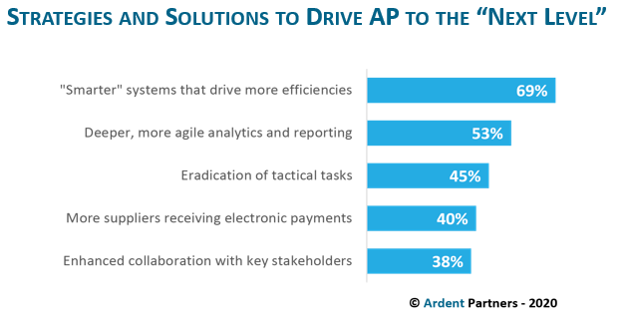Across every enterprise function, a real impact has been felt by the pandemic fallout. Procurement faces supply chain disruptions, finance must ensure there is funding to support operations, product management must rethink the pace and timing of development projects, IT needs the technology and infrastructure to support work from home directives, and HR faces unforeseen workforce management obstructions and the unfortunate task of layoffs and/ or furloughs. In the midst of this uncertainty, AP must continue its drive to become more efficient and “smarter.”
Operational efficiencies have long been a key objective for AP departments. However, it is the notion of “intelligence” that has become more important for AP in recent years, particularly because finance and other business leaders must do all they can to keep the enterprise moving forward in a safe and financially healthy manner. For the AP industry, the “age of intelligence” means that global businesses will be able to draw actionable knowledge from the invoice, payment, and supplier data that resides within ePayables systems and make smarter decisions. Interestingly, it is these two somewhat disparate concepts that a majority of AP professionals believe are potential “game changers.” As shown in the figure below which is taken from Ardent Partner’s State of Accounts Payable 2020 market research report, efficiency and knowledge are what AP leaders say they need to get them to the next level of performance.

The connective tissue for these two “levers for success” is automation. Accounts payable teams that harness the power of automation to drive operational efficiencies across core processes usually have access to deeper analytical capabilities than their non- automated peers. Nearly 70% of businesses believe that “smarter” systems, which typically offer more modern and advanced features and functionality, will accelerate performance. When smartly- deployed and well-adopted, full AP automation, which optimizes the entire invoice-to-pay process (including payment execution), can drive performance gains by digitizing the tactical, manually- intensive and error-prone activities that can hold an AP function back. The “smart” aspects of these solutions provide more nuanced technology, like machine learning or artificial intelligence, to provide next-level value beyond the eradication of paper.
Similarly, more agile reporting (which 53% of AP leaders believe can be used to propel them to success) takes reporting and analysis to another level. Standard financial reports driven from older AP systems typically offer a baseline view into department transactions but generally lack the ability to provide a “big picture view” and enable advanced analysis, both of which can transform the way the AP leaders (and other finance executives) set policies and track performance. Agile analytics build upon the transactional nature of invoice management (number of invoices, approvals, payment status, etc.) and transform the process into one that can incorporate liquidity and cash management, payment strategies and optimization, supplier management, fraud and compliance control, budget adherence, and more. With improved and more agile analytics, AP leaders can provide actionable intelligence to key partners such as CFOs, controllers, treasurers, CPOs, and business unit leaders, who can, in turn, leverage it for improved decision- making and corporate planning. Thus, it is the thirst for knowledge and a drive to continue AP’s journey towards optimization that can help transform the function from where it is today into a brighter, clearer, more strategic “tomorrow.”
The “future,” then, for the AP function, should be seen as an opportunity to not only prove its strategic value to the greater organization, but also to ensure continuity and resiliency that will help the business weather this difficult storm. Given the uncertainty as to the direction of both the economy and individual businesses, AP must develop a multi-pronged agenda to navigate into 2021 and beyond. The agenda should prioritize the business continuity and resiliency initiatives that are in place or will soon be. But, they must also focus on the future, and, where possible, begin to develop the organizational capabilities that will drive long-term success.
For too many years, AP lacked the voice and credibility needed to accomplish a transformation without the support of others. However, in the face of extraordinary times and a challenging business climate, AP groups now have the opportunity to drive tremendous value and help the greater enterprise navigate these tough times.







Comments are closed.